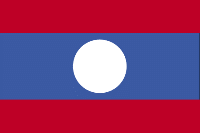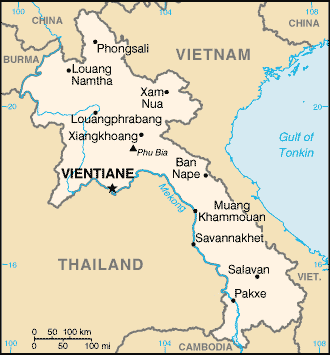Laos is located to the west of Vietnam and northeast of Thailand in Southeastern Asia. The total area of the country is 236,800 km2, and it has a population of 6,586,266 as of July 2011. The country’s climate is predominantly tropical monsoon.
 |
The national flag of Laos.
Image Credit: CIA Factbook. |
In the ancient times, Laos was a powerful country that covered present-day Cambodia and Thailand. Since 1907, it has been ruled by strict socialist regimes. However, in the 1980s, the government policies opened up to limited privatization and relaxation of foreign investment laws. In 1997, it became a member of Association of Southeast Asian Nations (ASEAN).
Although the economic growth of Laos was more than 7% per year during 2008 to 2011, the country’s infrastructure is still underdeveloped. However, the growth has decreased poverty from 46% in 1992 to 26% in 2010. The economy has gained a lot from high foreign investment in mining and construction. The GDP of Laos was $17.66 billion in 2011.
The natural resources of Laos include tin, gold, gemstones, and gypsum. The mining sector is not yet a significant player in the country’s economy.
Overview of Resources
In 2010, Laos built several exploration partnerships with other Asian countries. Some of them are listed below:
- China- for exploration of bauxite and potash
- Republic of Korea- for exploration of various mineral and energy resources
These partnerships improved the country’s economic development and cooperation with other Southeast Asian countries.
Laos produced many mineral commodities during 2010. The production of tin, copper concentrate, silver, and gold increased by 46%, 26%, 7.2%, and 0.6%, respectively, compared to that of the previous year.

The map of Laos. Image Credit: CIA Factbook
Metals
The metal industry of Laos has been a lot more successful and active than the other mineral commodities.
In 2010, the Sepon copper-gold project produced 64,241 Mt of copper cathodes and 3,252 kg of gold. In 2011, copper cathode production increased to about 80,000 t/yr owing to the expansion in the project, which was commissioned in 2010.
The 2010 production statistics from the Phu Kham copper-gold project is as follows:
- Copper concentrate - 67,806 t (25.5% increase compared to that of 2009)
- Gold- 1,809 kg (35% increase)
- Silver- 15,788 kg (7.2% increase)
PanAust anticipates an increase in its gold and silver production in 2012 as the Ban Houayxai project was commissioned at the end of 2011.
In 2009, Sino Australian Resources (Laos) Co., Ltd. (SA RCO) struck a joint-venture agreement with Lao LSI to acquire a 51% interest in the LSI tenement and conduct a feasibility study. Based on the feasibility study, the company expects to acquire a mining license for the LSI tenement. The joint venture plans to build a 600,000 Mt/yr-capacity alumina refinery near the tenement.
The Laos Bolaven Plateau bauxite project is developed by SA RCO, which is a joint venture between China Nonferrous Metals Industry’s Foreign Engineering and Construction Co., Ltd. with a 51% interest and ORD River Resources Ltd. of Australia with a 49% interest.
In 2010, Lao Iron and Steel Co. Ltd. began the construction work of its 500,000 t/yr- capacity iron and steel plant. The project cost around $180 million and was completed in 2011.
Industrial Minerals
SinoAgri Mineral Resources Exploration Ltd., a joint venture between Beijing Jiang Zhi Yuan Investment Ltd. and China National Agricultural Means of Production Group Corp., made a 30-year agreement with the Government of Laos for a potash mining license in 2009. A $37 million potash plant with a production capacity of 100,000 t/yr was planned in 2010.
Potash production is set to increase in the next few years as several mines and plants that began construction in 2010 will be completed shortly.
Investment
Laos is focused on developing its infrastructure and building business partnerships with its neighboring countries. The scope for the mining sector in the country is currently very good as the local demand for metals, construction materials, fertilizers, and fuel minerals is constantly growing. The demand from the international market is also growing in the recent years.
The government of Laos is also making efforts to be a part of World Trade Organization by fulfilling some of the criteria like reforming import licensing. Laos implemented a VAT tax system in 2010, and started its first stock exchange in 2011. The country is simplifying investment procedures and expanding bank credits as well.
All these favorable conditions have drawn the interest of global investors and companies. Australia’s Metro Machinery Group (MMG) is ready to sell Bt1.5 billion worth of Caterpillar construction and mining equipment to a gold and copper mine in Laos to boost its sales there to reach Bt10 billion this year. MMG’s interest in this region is due to the recent increase in mining activities and resultant growth in Laos.
Disclaimer: The Author of this article does not imply any investment recommendation and some content is speculative in nature. The Author is not affiliated in any way with any companies mentioned and all statistical information is publically available.
Sources and Further Reading
Disclaimer: The views expressed here are those of the author expressed in their private capacity and do not necessarily represent the views of AZoM.com Limited T/A AZoNetwork the owner and operator of this website. This disclaimer forms part of the Terms and conditions of use of this website.